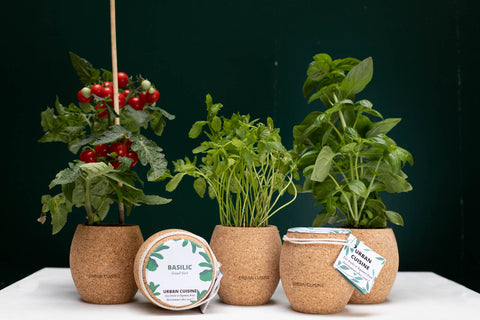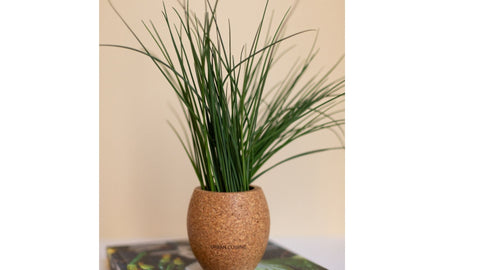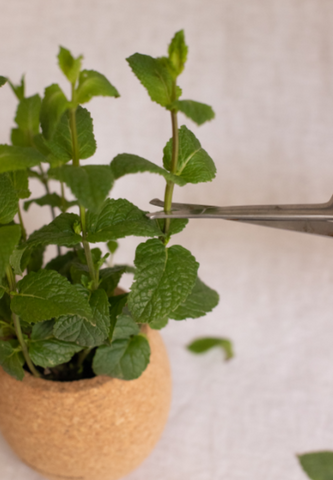Oh no, it looks like your cart is empty...

Indoor vegetable garden: tips and tricks
|
|
Time to read 14 min
Oh no, it looks like your cart is empty...
|
|
Time to read 14 min
Have you decided to embark on the adventure and cultivate from your home your fruits, your vegetables and your aromatic herbs? Great initiative! Urban Cuisine supports you and shares with you advice and small tips for A successful interior vegetable garden!
Who has not dreamed of having fruits, vegetables and Organic aromatic herbs Even edible, quality and large quantity flowers from home? It is however simple and accessible thanks to the Interior vegetable garden.
 There are obviously a multitude of possibilities forCreate and succeed in your interior vegetable garden. First of all, the question of the support for your Clod. So, to plant from home, you can choose the traditional clay pots, or opt for terracotta jars, these two options offer the advantage of being more resistant than plastic pots. It remains important in all cases that the pot be pierced in the bottom to allow a good drainage and guarantee the good roots health.
There are obviously a multitude of possibilities forCreate and succeed in your interior vegetable garden. First of all, the question of the support for your Clod. So, to plant from home, you can choose the traditional clay pots, or opt for terracotta jars, these two options offer the advantage of being more resistant than plastic pots. It remains important in all cases that the pot be pierced in the bottom to allow a good drainage and guarantee the good roots health.
The question of content is nevertheless inseparable from that of the container. It will then be necessary choose the best pot Depending on what you want to plant it. The plastic pot is too light to plant trees, and will not resist bad weather like strong winds. The geotextile pot is particularly suitable for the cultivation of aromatic herbs, fruits and vegetables And organic flowers because it allows good root development in that it is very ventilated.
Nevertheless, the space and the budget available vary for each person and are also factors to take into account in the creation of your interior vegetable garden, therefore free to opt for the solution which seems to him the best in view of his situation.
After selecting the adequate container, you must now look at the question of content. The choice of soil is of primary importance to allow you to grow easily. Each plant has its own needs is therefore to a land adapted to them to meet them.
However, keep in mind that a good soil is light, it should allow the roots of the plant to anchor while allowing it to find the necessary air. It must offer a good conservation of water and at the same time allow it to run into it so that the roots do not rot. THE PH Ideal for your soil is between 5.5 and 6.6. Likewise, it would have to contain nutrients, at least during the first months of its use. All these conditions met guarantee quality soil.
You can naturally orient yourself towards a soil called “universal”It is also the privileged land for indoor cultivation since around 90% of the plants in our interior vegetable gardens benefits.
 The tools necessary for your interior vegetable garden are obviously not the same as those used for the garden or the external culture. The use of three tools will however be of a great appeal. THE transplant, which allows Dig and manipulate the earth. THE shears For cut the small branches. The last tool is the rake that will allow you to scrape the surface of the earth To make the fertilizer or the compost penetrate. This tool kit is a necessary basis to help cultivate your seeds.
The tools necessary for your interior vegetable garden are obviously not the same as those used for the garden or the external culture. The use of three tools will however be of a great appeal. THE transplant, which allows Dig and manipulate the earth. THE shears For cut the small branches. The last tool is the rake that will allow you to scrape the surface of the earth To make the fertilizer or the compost penetrate. This tool kit is a necessary basis to help cultivate your seeds.
You wonder what place for your Apartment would be the most suitable to place your vegetable garden ? Rest assured, lSolutions available to you are multiple.
The first place you think of to install your vegetable garden is surely the balcony. You are right, this option will offer your plants a Good sun exposure And a place of choice to grow fruits, vegetables and quality organic aromatic plants. You can harvest everything you sow, by not forgetting to water, and this, and this, without cluttering your interior space.
You have the chance to have a terrace ? So you might as well use this space as it should be to develop your plantation! Thanks to the place offered by the terrace, you can multiply the varieties to plant and group those with the same water and sun needs to facilitate the work. Likewise, you can separate them from more invasive varieties that require more space and special care. If your accommodation is also well oriented, your plants will receive all the sun they need and will offer you A vegetable garden on the terrace Rich in harvests!
We may think there is less but the vegetable garden in the kitchen remains an interesting locationTo cultivate aromatic plants and herbs. Indeed, the kitchen is often a bright and fairly well -heated room, rather humid and one of the less furnished so quite slightly crowded. All this will facilitate the growth of everything you can plant!
Aromatic plants Allow you to taste the simplest dishes and even recipes. For the most part, they push very well indoors because they need only little space. Their development obviously requires water and light But these plants actually require little maintenance and are therefore ideal for great beginners or those who do not have much time.
There is a very large choice of organic herbs that you can have in your vegetable garden. Let us note for example:
Urban Cuisine especially suggests four varieties: Green mint, The flat parsley, The Basil Grand Green and theCommon chives. These four varieties have the specificity of growing quickly, in a few weeks or months only, and to be easy to maintain!
 You can also find all our maintenance tips and all our best recipes on our site. The possibilities of recipes are indeed numerous and these spices will bring taste and freshness to all your dishes, all year round!
You can also find all our maintenance tips and all our best recipes on our site. The possibilities of recipes are indeed numerous and these spices will bring taste and freshness to all your dishes, all year round!Aromatic plants each have their specificities and do not in fact have the same requirements in terms of maintenance, soil and watering. So we guide you to make the Best associations possible to discover What aromatic plants to plant together.
We recommend you :
THE thyme, THE rosemary, Sage And all Mediterranean herbs need a Exposure in full sun and a perfectly drained soil, including dry and poor. While the Basil, chives and tarragon Also appreciate the sun (however they support mid-shade), but ask for a fresher. THE parsley and chervil are cultivated at partial shade in a fresh ground ; there mint Also, but it is more accommodating and supports any type of exhibitions.
Remember that certain plants must imperatively remain isolated:
Didn't you know it until then? And yet! Push inside vegetables is possible.
THE mini vegetables are actually very easy to do push inside and in a limited space. They only ask for little attention and are therefore very easy to cultivate and will therefore be ideal in your plantation!

It is, for example, quite possible in your plantation, to grow Mini peppers, or some Mini peppers, which will bring taste and color to your dishes.
You can just as well orient yourself towards there Lettuce to cut, which also has the particularity of pushing very quickly. You will therefore often have to eat and you can enjoy Light and delicious meals.
But there are many possibilities, you can very well plant:
Proof is that Vegetables will find easily their place in your interior And will offer you great harvests after just a few weeks depending on the varieties!
Each variety has specific needs that it is important to know well. In order for them to benefit from the best conditions, it is however important that each of the clods of your interior garden receive Light at least 5 hours a day. It is not necessarily that of the sun but the plants still need light to grow. Too much sun could, however, dry your vegetable garden, full sun is not always ideal. Thus, having a balcony or a terrace allows you to multiply the possibilities.
Likewise, it is important to Do not neglect watering to ensure that your aromatic herbs, your fruits and your organic vegetable plants The water required for their growth.
Finally, a Too large exposure to the wind is to be avoided. It is important that your vegetable garden is well sheltered from different bad weather that could constitute an obstacle to the cultivation of your different fruits, vegetables, your Organic aromatic flowers and herbs that you plant.
Each variety pushes its own methods. It is therefore important to know the particularities of each. Clods require a certain water supply, in light and heat. For example, you should remember that a temperature of a minimum of 15 degrees is necessary for varieties such as the Cherry tomato, THEMini peppers or the Basil Grand Green. However, do not panic since you can find, for all the varieties that we offer the clods, Our maintenance advice on our site.
Don't get me wrong, a season like Winter It is not synonymous with a stop time for the development of the content of your pots. Indeed, if they are mostly sown from the early summer, the fruits and vegetables you can harvest in winter nonetheless remain numerous. In December and with the arrival of winter you can then harvest all kinds of cabbage: cauliflower, Brussels cabbage, white or green cabbage ...
On the fruit side, you can very generously appreciate apples, oranges or pears.
This is just an overview because the possibilities are very numerous. To take advantage of seasonal products, it is important to Plant and harvest varieties at the right time. We therefore advise you to hold a planning of your plantations and harvests.
To learn more about this, we invite you to consult our Seasons !
THE aromatic herbs must be picked at a specific time, when they have reached a good level of development. In the morning is the ideal moment during the day for this operation, since it is not yet too hot and your harvests are not likely to be altered.
 The harvest of an aromatic herb depends on its type and different criteria. For the Annual herbs such as dill, the Basilic, chervil and parsley, being sown every year, they harvest themselves in the year.
The harvest of an aromatic herb depends on its type and different criteria. For the Annual herbs such as dill, the Basilic, chervil and parsley, being sown every year, they harvest themselves in the year.As to perennial plant, such as chives, tarragon, Mint, rosemary, sage or thyme, they harvest as soon as the plant is sufficiently resistant to samples. This resistant is generally acquired after several weeks, and even Several months of culture.
In order for your plants to give you good harvests, it is also important to cut regularly. This will allow you to encourage the production of new branches and therefore ensure the productivity of your plantation for many weeks. For this operation, two of the kit tools already mentioned above will be useful to you: The transplanted and the pruning sheer.
You come from Cut your herbs And you wonder now How to keep your aromatic herbs ? Two conservation possibilities are available to you: drying And freezing.
The drying technique allows you to Keep the scent of your herbs fresh.

To get this conservation method, it will be necessary to make sure your stems are first dry, for that you can Allow to dry in the open air On a clean cloth for 3 hours if they are not or gently dry them, so as not to damage the leaves. The stems you have taken must then be grouped and then surrounded with an elastic. Then place them in a dark place. The elastic will tighten when the stems are dry. This solution will allow you to keep your herbs for a few months or a year.
The second solution available to you is freezing your herbs. This method allows Keep your aromatic herbs longer than drying. Especially for keep THE parsley Or the chervil, it is important to freeze them immediately after picking to keep all the flavors of herbs. THE High herbs also keep better once frozen. This method is particularly suitable for keep coriander and the dill. Fine herbs can be kept whole or chopped in small pieces using a knife. The prison parsley stems can for example be put whole in the freezing sachet because the parsley picks up on its own with the cold. Then start by cutting the stems and then pass the herbs in clear water. For varieties that have more fragile leaves, think of Do not pour the water directly on the leaves And use your hands to soften the rinsing. Then dry them on a clean cloth for 3 hours or dry them directly with the cloth, being careful not to offend the leaves. It is best to cut the herbs with a knife and not to the blender to prevent herbs from being dislocated with water. Remember to register the name of the variety of the grass and the harvest date on the freezing bag with an indelible felt before closing the bag and putting it to freeze. You should know that basil blackens freezing, to avoid this you can transform it into pesto or chop it to put it in an ice cube tray and then cover it with oil before freezing it.
Eager to acquire a vegetable garden that will allow you to Planting quality organic, vegetables, flowers and aromatic herbs And even without a garden, and this, effortless and throughout the year? We understand you and guide you to better make your choice among vegetable gardens. To make your task for the cultivation of fruits, vegetables, flowers and organic aromatic herbs from your vegetable garden, you can orient yourself towards a connected vegetable garden.
Apartment culture is not always obvious. Lack of space, lack of time, lack of lighting ... to overcome all these shortcomings there are nevertheless Connected vegetable gardens. The connected vegetable garden, also called intelligent garden, or Smart Garden in English, makes it possible to grow organic fruits, vegetables and aromatic herbs thanks to a system that includes artificial lighting. This artificial lighting makes it possible to reproduce the sunshine from which you plant in a garden for example. In addition to offering the lighting necessary for your plantation, the connected vegetable garden also protects your pots from external weather.
Urban Cuisine, supported by the desire to democratize urban agriculture and make gardening as accessible as possible, has developed an optimized vegetable garden for you, an at the forefront in intelligent vegetable patch and Made in France, which is in addition Customizable!
Our connected interior vegetable garden, produced and manufactured in France, will allow you to cultivate all year round and simultaneously Twenty plants of your choice.
If you don't have much time to spend your plants, don't worry the vegetable garden is optimized. All settings such asAt temperature, humidity are automated thanks to a integrated system to the vegetable garden in order to Guarantee the growth of all of your plants!
Our connected interior vegetable garden offers the advantage of being extremely simple has install and use. Just connect it to an electrical outlet upon receipt, fill the water tank and install your crop clods. Urban Cuisine has even developed an algorithm for you that will advise you for the placement of your clods in order to make sure you benefit from the best possible harvests!
The crops will be of high quality with our connected vegetable garden, but also great speed. Know that the first shoots will appear after only a week and the crops can be performed from two weeks depending on the cultivated varieties.
Finally, the Urban Cuisine's connected vegetable garden offers the advantage of being fully made in France from French wood from sustainably managed forests.
Sober and ergonomic, of a sleek style, our product will be perfectly integrated into the decoration of your apartment and will delight your interior!

<<< Discover our connected vegetable garden >>>